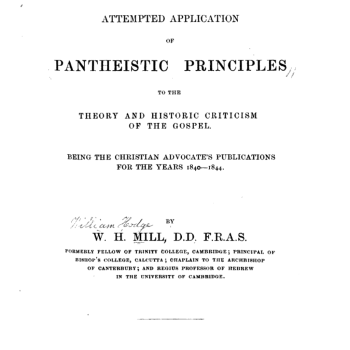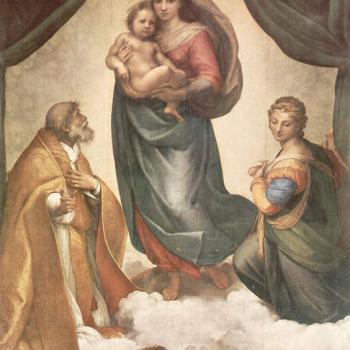This exchange occurred at Cranach: The Blog of Veith: a Lutheran site, in the combox for the post “Mariology.” I was initially responding to the question of how “Catholic” Luther’s Mariology was, later in his life. I said it was relatively more so; others thought the opposite. I gave three quotes from one of my papers on the topic, which were then disputed. I was asked to give full documentation (which I had already done in my existing papers). Then folks started getting very angry about it when I thoroughly backed up my citations . . .
Dr. Gene Veith =blue
Till his death, too, in many ways. As far as I know, he (along with virtually all early Protestant leaders) never ceased believing in Mary’s perpetual virginity, or the propriety of calling her Mother of God (Theotokos or Mater Dei). He held even later in life a modified version of what Catholics believe in the Immaculate Conception: that Mary was purged of original sin and was sinless at the birth of Christ and after. I have called this view, “Immaculate Purification.” It is like ours insofar as she was freed from original sin by God’s grace at some point; different in that it was not at her conception. The early Luther (as late as 1527 for sure and possibly later) even believed the latter.
Luther wrote in 1540:
In his conception all of Mary’s flesh and blood was purified so that nothing sinful remained. [1]
And in 1543:
. . . a holy virgin . . . freed of original sin and cleansed by the Holy Ghost . . . [2]
And in 1543-1544:
But in the moment of the Virgin’s conception the Holy Spirit purged and sanctified the sinful mass and wiped out the poison of the devil and death, which is sin. Although death remained in that flesh on our account, the leaven of sin was nevertheless purged out, and it became the purest flesh, purified by the Holy Spirit and united with the divine nature in one Person. . . . with the Holy Spirit overshadowing it, active in it, and purging it, in order that it might be fit for this most innocent conception . . .
But later, when the time for assuming the flesh in the womb of the Virgin came, it was purified and sanctified by the power of the Holy Spirit, according to Luke 1:35: “The Holy Spirit will come upon you and will overshadow you.” . . . this flesh He assumed later, after it had been purged, . . .[3]
I don’t think he ever denied that Mary’s Assumption was a perfectly permissible belief, either, though never required in his circles. All of that is far more “Marian” that (I’d venture to guess) maybe 95% of Lutherans today. A lot closer in spirit to us than to y’all, I dare say . . .
I don’t believe that Luther, not even the Luther of 1521, believed that the Virgin Mary was without sin. Why not? This would have directly warred against the very foundation of his theology. And that theology was this: Only faith knows to be terrified at ALL its best and most virtuous works and so then only faith also knows that it needs to hide ALL those works in the Works of Another.
And it is THIS faith that is Original Righteousness and the Image of God that Adam lost and is now restored in the New Man only through Holy Baptism. So I am certain that Mary had this faith. I am also certain that Luther had no illusion that Mary also lacked an Old Adam. (10-6-11)
They are legitimate quotations. I already gave links where I documented them. Granted, it is work to find them, though, so I’m happy to do all the work.
Example One:
In his conception all of Mary’s flesh and blood was purified so that nothing sinful remained. (1540)
This is the translation of Lutheran scholar Eric W. Gritsch, who was a major translator involved in Luther’s Works, including, for example, the lengthy treatise, Against the Roman Papacy: An Institution of the Devil (vol. 41, 263-376). It comes from the following book:
The One Mediator, the Saints, and Mary, Lutherans and Catholics in Dialogue VIII, edited by H. George Anderson, J. Francis Stafford, Joseph A. Burgess, Minneapolis: Augsburg Fortress Press, 1992.
From Gritsch’s chapter 8, “The Views of Luther and Lutheranism on the Veneration of Mary” (pp. 235-238), but it is in a footnote on p. 381. Here is the fuller context (my bolding):
As Luther put it in 1540: “In his conception all of Mary’s flesh and blood was purified so that nothing sinful remained. Thus Isaiah is correct in saying, ‘There was no deceit in his mouth’ [53:9]. Each seed was corrupt, except that of Mary.”
[footnote 23; p. 381: “Disputation on the Divinity and Humanity of Christ,” February 28, 1540. WA 39/2:107.8-13.]
The primary source is available in its entirety online, translated from the Latin (WA) by Christopher B. Brown:
In that rendering, the same portion is as follows (my bolding and caps):
in conception the flesh and blood OF MARY were entirely purged, so that nothing of sin remained. Therefore Isaiah says rightly, ‘There was no guile found in his mouth’; otherwise, every seed except for Mary’s was corrupted.
Gritsch further observes (my bolding):
Luther’s views on Mary after 1521 are not substantially different from those he presented in the Magnificat. (p. 237)
In 1527 Luther dealt with the Immaculate Conception of Mary, advocating a middle position favored by a majority of theologians. Following Augustine, Luther told his congregation that Mary had been conceived in sin but had been purified by the infusion of her soul after conception. Her purification was complete due to a special intervention of the Holy Spirit, who preserved her from the taint of original sin in anticipation of the birth of Christ. (Ibid., p. 238)
Two scholars doubt whether Luther affirmed the doctrine of the Immaculate Conception of Mary: Preuss (n. 11 above came to the conclusion that Luther rejected the doctrine after 1528; O’Meara states that “it is likely, but not certain” that Luther rejected the doctrine (118 [n. 11 above]). But Tappolet (32 [n. 1 above]) demonstrated with the use of texts that Luther did not change his mind. The literary evidence from Luther’s works clearly supports the view that Luther affirmed the doctrine, but did not consider it necessary to impose it. (Ibid., footnote 43; p. 382)
. . . a holy virgin . . . freed of original sin and cleansed by the Holy Ghost . . . (1543)
This is from Gerhard Falk, in his book, The Jew in Christian Theology: Martin Luther’s Anti-Jewish Vom Schem Hamphoras (McFarland & Co.: 1992, p. 217). This can be viewed online.
See also, Beth Kreitzer, Reforming Mary: Changing Images of the Virgin Mary in Lutheran Sermons of the Sixteenth Century (Oxford University Press: 2004):
In a later writing Luther insists that Mary was ‘saved and purified from original sin through the Holy Spirit’ at some point before Christ’s incarnation, although he does not specify when this happened. [99] (p. 124)
[99] Vom Schem Hamphoras und vom Geschlecht Christi, 1543, WA 53, 640: “[Maria ist] ein heilige Jungfraw, die, von der Erbsunde erloset und gereiniget, durch den heiligen Geist.” Ebtener thinks that because this statement falls in the context of a defense of the incarnation, Luther means that Mary was purified at that point. Others (e.g., Schimmelpfennig) believe that this phrase still supports the immaculate conception. See Ebneter, “Martin Luthers Marienbild,” 78-79. [view online]
See also Bridget Heal, The Cult of the Virgin Mary in Early Modern Germany: Protestant and Catholic Piety, 1500-1648 (Cambridge University Press: 2007):
Yet he still, in 1543, felt able to write that Mary was ‘a holy virgin, who was saved and purified from Original Sin by the Holy Ghost’, although he no longer specified at what point this purification took place. [157] (pp. 58-59)
[157] WA, vol. 53, p. 640. [view online]
But in the moment of the Virgin’s conception the Holy Spirit purged and sanctified the sinful mass and wiped out the poison of the devil and death, which is sin. Although death remained in that flesh on our account, the leaven of sin was nevertheless purged out, and it became the purest flesh, purified by the Holy Spirit and united with the divine nature in one Person. . . . with the Holy Spirit overshadowing it, active in it, and purging it, in order that it might be fit for this most innocent conception . . .
But later, when the time for assuming the flesh in the womb of the Virgin came, it was purified and sanctified by the power of the Holy Spirit, according to Luke 1:35: “The Holy Spirit will come upon you and will overshadow you.” . . . this flesh He assumed later, after it had been purged, . . . (1543-1544)
This is from Luther’s Works (LW), vol. 7, Lectures on Genesis Chapters 38-44 (translated by Paul D. Pahl), excerpts from pp. 12-13 and p. 31. I have this volume (hardcover) in my library (I have some but not all of LW).
In Luther’s reference above to Lk 1:35, the “overshadowing” referred to Mary, not Christ (this is the Annunciation); and Luther tied that in to her flesh being purged and purified. Jesus’ flesh cannot be purged from sin because no sin was ever in it to begin with, based on the Hypostatic Union and His deity. To deny that is again Nestorian heresy and (insofar as Christ is said to be sinful in any sense), I submit, blasphemous.
This is the kind of Christological error that filled the movie, The Last Temptation of Christ. Heaven forbid that Lutherans fall into that. You can’t, according to your own confessions. E.g., Formula of Concord, Solid Declaration, Article I: Original Sin (43-44):
43] Secondly, in the article of Redemption the Scriptures testify forcibly that God’s Son assumed our human nature without sin, so that He was in all things, sin excepted, made like unto us, His brethren, Heb. 2:14. [omit Latin] That is: Hence all the old orthodox teachers have maintained that Christ, according to His assumed humanity, is of one essence with us, His brethren; for He has assumed His human nature, which in all respects (sin alone excepted) is like our human nature in its essence and all essential attributes; and they have condemned the contrary doctrine as manifest heresy.
44] Now, if there were no distinction between the nature or essence of corrupt man and original sin, it must follow that Christ either did not assume our nature, because He did not assume sin, or that, because He assumed our nature, He also assumed sin; both of which ideas are contrary to the Scriptures. But inasmuch as the Son of God assumed our nature, and not original sin, it is clear from this fact that human nature, even since the Fall, and original sin, are not one [and the same] thing, but must be distinguished.
Luther was referring to Mary’s flesh (not her “nature”) that Jesus then received, so that He had a human nature. And what we see in this work can be understood as in line with other similar utterances of Luther’s.
I list dozens of opinions of Lutheran scholars at length in my four papers on the topic.
I already DID. Past tense: D——I——D. It was all in my papers that I linked to (as I plainly stated). Why am I required to do all that work when I already did it? I’m not. We have search capacities now (Ctrl-F). Things can be located in one second. I have no such obligation to produce what I already have, online, for the record. I don’t have unlimited time.
But I did it anyway, so we can be rid of silly complaints. . . . in this case it was all thoroughly done already: documented to the nth degree, in existing papers. If anyone is able to read, they can find them, if they are so concerned about it and want to question their validity.
Links are wonderful. We can link now and say: “the sources are over there if you wanna see ‘em.” It’s like a high-tech footnote. But the Luther quotes ARE THERE! They exist! I pulled them out in a more convenient manner and now anyone can see for themselves. If they wanna pick a fight with Luther’s Works, Gritsch (one of the guys in LW) et al, questioning their translation and understanding of same (now Gritsch is in the business of offering “bogus” Luther quotes?), I would enjoy watching that.
***














